Saturday, November 05, 2005
KOCHI MANGA FESTIVAL 2005 -PART 1-
 November 3rd is our national holiday called “Culture Day” and many culture- related or culture-promoting events are held all over Japan this day. Me? I went to see the one that is very "Japanese." Tea ceremony or flower arrangement? No. I went to the “Manga (Japanese comics) Festival” at the community cultural center named “CulPort.”
November 3rd is our national holiday called “Culture Day” and many culture- related or culture-promoting events are held all over Japan this day. Me? I went to see the one that is very "Japanese." Tea ceremony or flower arrangement? No. I went to the “Manga (Japanese comics) Festival” at the community cultural center named “CulPort.”I don't see myself as a manga/anime fanatic, but admit that I'm an avid manga advocate (except some erotic manga/anime). As I wrote in my previous manga-related post, I strongly believe that manga is one of our valuable cultural assets. Many people may still see manga as something lower than novels, but I see manga as one legitimate mean of expression which involves both language AND pictures, stimulating both left and right hemispheres of the brain.
I have been told thousands of times that reading manga would make you less intelligent, because with the help of pictures it is too easy to understand the content thus you don’t really need to “think,” but I am not fully convinced. I used to have a friend in Osaka, who was about my age, and she had read very little manga since her childhood because their parents told her manga would make her stupid. Instead, she read a lot of novels. So you might think she should be terribly intelligent, but she almost always had difficulty following the stories when we went to movies together, especially with fast-paced Hollywood films. Do you think not reading manga helped her bing intelligent?
As I wrote in my previous post, manga is not only “funny stuff for kids,” and almost any theme can be successfully expressed in an art-form called manga, including serious social issues and touching human dramas. My belief is this: if manga can communicate complicated and often boring issues a lot easier and clearer to a wider range of people, why not fully enjoy that benefit? That kind of communication skill must be valuable in this modern international society. Of course, I never want manga to overtake pure novels; I want them to co-exist as equally valuable varieties, and I believe people are flexible and multi-faceted enough to enjoy both. Perhaps some ideas are definitely needed to make novel-reading as attractive for kids as manga in order to keep kids’ reading ability, but forbidding manga is not one of them, I think.
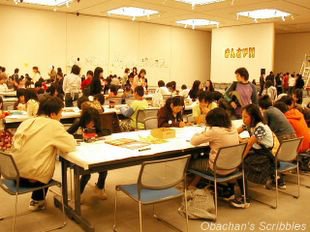 OK, enough of rationalization. There were so many kids and adults at the manga festival having a good time. There they were able to see exhibits of artworks by local manga authors, and also participate in games and activities.
OK, enough of rationalization. There were so many kids and adults at the manga festival having a good time. There they were able to see exhibits of artworks by local manga authors, and also participate in games and activities.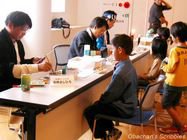 Right near the entrance was a place where kids could have their portraits drawn by local manga authors.
Right near the entrance was a place where kids could have their portraits drawn by local manga authors.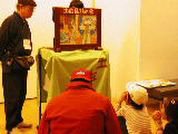 Picture-story show familiarizing kids with local folk tales.
Picture-story show familiarizing kids with local folk tales.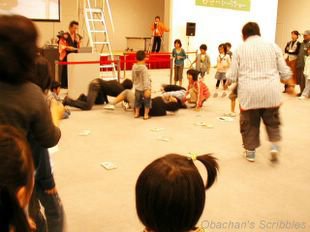 Manga karuta. The narrator read catch-phrases and popular quotes from various manga, and participants were supposed to pick the correct one out of 20 to 30 manga books on the floor. I was really tempted to participate, but the game was for kids only (of course) ;P
Manga karuta. The narrator read catch-phrases and popular quotes from various manga, and participants were supposed to pick the correct one out of 20 to 30 manga books on the floor. I was really tempted to participate, but the game was for kids only (of course) ;P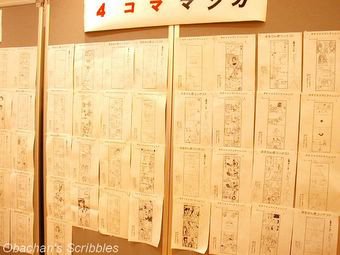 Activity of drawing four-frame comic strips freely or with a given theme and character. Isn’t this a highly-intellectual task? I was honestly amazed that so many kids were interested in doing this and showing real enthusiasm and concentration. It does require several hours of continuous work, and none of them had to be forced by parents! The photo shows about 1/3 of all the entries.
Activity of drawing four-frame comic strips freely or with a given theme and character. Isn’t this a highly-intellectual task? I was honestly amazed that so many kids were interested in doing this and showing real enthusiasm and concentration. It does require several hours of continuous work, and none of them had to be forced by parents! The photo shows about 1/3 of all the entries. From the entries of the "Four-frame comic strips contest." There were several entries from abroad, too, I heard. Can you guess the title of this one? (The white little things in the bottme frame are fish swimming in the ocean.)
From the entries of the "Four-frame comic strips contest." There were several entries from abroad, too, I heard. Can you guess the title of this one? (The white little things in the bottme frame are fish swimming in the ocean.) These panels are the works by the winners of “Manga Koshien,” a national cartoon drawing contest for high-school students held in Kochi annually.
These panels are the works by the winners of “Manga Koshien,” a national cartoon drawing contest for high-school students held in Kochi annually. Koshien is a famous baseball stadium where national high-school baseball tournament is held every year, so here they use the word Koshien to mean a "national competition" for high-school students. Each entry is drawn on one panel, so it is more like satirical cartoon than a manga story.
Koshien is a famous baseball stadium where national high-school baseball tournament is held every year, so here they use the word Koshien to mean a "national competition" for high-school students. Each entry is drawn on one panel, so it is more like satirical cartoon than a manga story.
© Takashi Yanase
I got a permission from the staff there to post this pic. on my blog. This is a piece of work by the author of popular anime, anpanman, and the author is originally from Kochi prefecture. On this white, thin kimono are an illustration of anpanman and a part of the theme song from the TV series. I thought the idea of having this kind of drawings on kimono was really fascinating. There were several more with illustrations and autographs by other manga authors from Kochi.
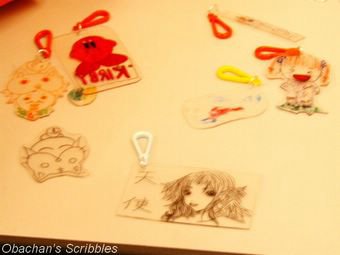 Manga key-holder making. I think they had kids draw their favorite manga characters on pieces of plastic (celluloid?) and heated them in toaster oven and made into key holders.
Manga key-holder making. I think they had kids draw their favorite manga characters on pieces of plastic (celluloid?) and heated them in toaster oven and made into key holders.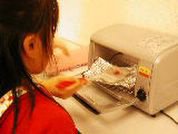
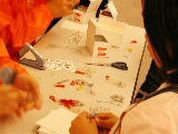
In my childhood, I had absolutely no experience of being officially encouraged to draw manga like this at school, at home or anywhere. Kids here experienced today something that I and their parents had never experienced in childhood. When these kids grow up and be parents, would they still have this kind of manga festivals? I'm very curious about that.
I saw some other interesting shows and games on the program, including a talk show by a voice actor, but unfortunately I missed many of the ones scheduled in the morning. Too bad.
posted by obachan, 11/05/2005 05:34:00 PM


